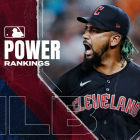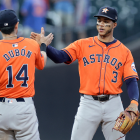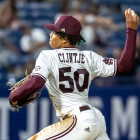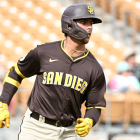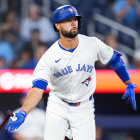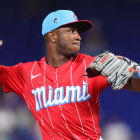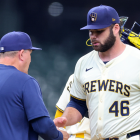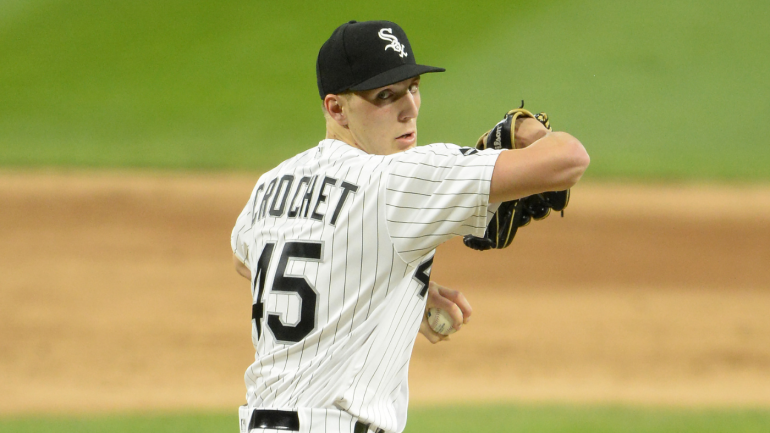
The arrival of the offseason means that it's time to rank stuff. Already this winter, we've sized up the 60 best free agents, both on an overall and positional basis. There's no law that prevents us from ranking minor-league players in addition to their big-league counterparts. As such, we're going to spend the winter evaluating every team's farm system.
The lack of a minor-league season makes that more of a challenge this year. It doesn't help that some teams opted against sharing video and data from their alternate-site camps with the rest of the league. As such, we've opted against overthinking this. Our rankings will essentially be the same as they were last winter with a few changes. First, we'll exclude anyone who graduated by exhausting their rookie eligibility; second, we'll replace them with draftees or other worthy prospects; and third, and lastly, we'll present the information in a new format.
In every article in this series, you'll find a team's top five prospects as well as five others we felt like including, either because of their promise or some other reason. For those top five prospects, you'll find a quick summation of their pros (their saving grace, if one will) and their cons (their fault line), as well as beefier report and our attempt to peg their "likeliest outcome."
These rankings were compiled by talking to industry folks -- scouts, analysts, and other evaluators -- and include a touch of our own evaluative biases. Remember, that this is more of an art than a science, and that the write-ups matter more than the rankings themselves.
Now, let's get on to the top five prospects in the Chicago White Sox system.
1. Michael Kopech, RHP
Age (as of 4/1/2021): 24
Height/Weight: 6-foot-3, 225 pounds
Acquired: Part of the Chris Sale trade (Red Sox)
Highest level: MLB
Saving grace: Fastball
Fault line: Last two years
Scouting report: Kopech appeared to have made significant strides with his command before making his big-league debut in 2018. He then tore his UCL after four starts, causing him to miss the entire 2019 season in the process. Kopech was supposed to be a big part of Chicago's rotation plans this year, but he opted out of the season before it started, leaving him more than two years removed from his last meaningful pitch. Kopech has top-notch stuff; there's just too much riding on his command to feel confident projecting more than a mid-rotation arm for now.
Likeliest outcome: Mid-rotation starter, perhaps more
2. Andrew Vaughn, 1B
Age (as of 4/1/2021): 23
Height/Weight: 6-foot, 215 pounds
Acquired: No. 3 pick in the 2019 draft (Cal)
Highest level: High-A
Saving grace: Bat
Fault line: Right-right first baseman
Scouting report: Vaughn is comparable in many ways to Spencer Torkelson, the No. 1 pick in the 2020 draft. They're both right-handed first basemen from the west coast who have all the tools -- eye, bat speed, strength, feel for contact and making adjustments -- and who should move quickly through the minors before taking their rightful spots in the middle of an order. On that note, there's a fair chance Vaughn will make his big-league debut before the year is over.
Likeliest outcome: Starting first baseman
3. Garrett Crochet, LHP
Age (as of 4/1/2021): 21
Height/Weight: 6-foot-6, 218 pounds
Acquired: 11th pick in the 2020 draft (Tennessee)
Highest level: MLB
Saving grace: Arm strength
Fault line: Injuries
Scouting report: Crochet's professional debut came in the form of his big-league debut. He appeared in five regular-season games and a postseason game, showing off triple-digit velocity and an occasional swing-and-miss slider. Unfortunately, Crochet left his final appearance with an injury, which is a common theme for him. He made just one start before the college season was shuttered because of a physical issue, and other teams had reservations about his medicals during the draft process. There's no denying Crochet's impressive raw stuff -- he just might have to make his impact in a relief role if his body doesn't hold up under a starter's workload.
Likeliest outcome: Mid-rotation starter or end-game reliever
4. Nick Madrigal, 2B
Age (as of 4/1/2021): 24
Height/Weight: 5-foot-8, 175 pounds
Acquired: Fourth pick in the 2018 draft (Oregon State)
Highest level: MLB
Saving grace: Hit tool
Fault line: Power
Scouting report: Madrigal is a unique talent. He has elite bat-to-ball skills that allow him to make contact on nearly 90 percent of his swings; he's also a fast runner and a skillful defender at the keystone. What he's not is someone who's going to draw many walks or hit for any power. His average exit velocity during his big-league stint was 84 mph, which put him in company with the likes of Tony Wolters, Delino DeShields Jr., and other undesirable hitter types. The good news for Madrigal is that those individuals are still big-league players, and that his maximum exit velocity (112) was a good deal higher, suggesting he's still likely to hit for a better average than they can and do. He'll need it in order to avoid the bottom of the order.
Likeliest outcome: Novelty; starting second baseman
5. Jonathan Stiever, RHP
Age (as of 4/1/2021): 23
Height/Weight: 6-foot-2, 215 pounds
Acquired: Fifth-round pick in the 2018 draft (Indiana)
Highest level: MLB
Saving grace: Fastball
Fault line: Secondary offerings
Scouting report: Stiever enjoyed a pop-up season in 2019, improving his stock to the point that other teams were asking for him in trade talks. Obviously the White Sox fended off those inquiries. Stiever has a quality fastball that sat around 92 mph during his big-league stint and that features a spin rate exceeding 2,300 rpm. In order to avoid a future in relief, he'll need to find more consistency with his secondary offerings, particularly a slider and changeup that missed big-league bats on about 10 percent of the swings taken against them. That won't play.
Likeliest outcome: No. 4 starter
Five others to know
- Jared Kelley, RHP
Kelley had a good deal of helium heading into the draft thanks to his impressive velocity and above-average changeup. He slipped to the second round because of concerns over his ability to spin the baseball and his conditioning.
- Dane Dunning, RHP
Part of the Adam Eaton return alongside Lucas Giolito and Reynaldo Lopez, Dunning made seven starts at the big-league level in 2020, posting a 3.97 ERA and a 2.69 strikeout-to-walk ratio. He probably won't pitch quite that well heading forward, but he has an average fastball and a good slider and he should occupy the back of a rotation so long as he stays healthy.
- Matthew Thompson, RHP
Thompson, Chicago's second-round pick in 2019, is an athletic right-hander with a quick arm and an aesthetically pleasing delivery. Both of his breaking balls have shown promise in the past, and their development could dictate if he's able to stick in a rotation.
- Yermin Mercedes, Hitter
Mercedes isn't your traditional prospect. He's nearly 28 years old, offers little defensive value, and has played for multiple organizations, including a few indy teams. Nevertheless, Mercedes reached the majors in 2020 because he can hit. He split 2019 between the upper minors, batting .317/.388/.581 with 23 home runs and promising peripherals, and there's no real reason to think he can't be effective at the big-league level. He's just probably in the wrong organization for getting a lengthy look at DH given the other candidates the team can call upon instead.
- Gavin Sheets, 1B
Sheets has the kind of big-time raw power typically associated with first-base/DH types … he just seldom puts it on display during games. His 16 home runs in 2019 represented a new career-high, yet he still failed to post an ISO over .150. Sheets isn't going to offer much secondary value -- he'll be a scratch defender, at best -- so clearing the fence more often is going to be necessary if he's going to have a lengthy big-league career.










